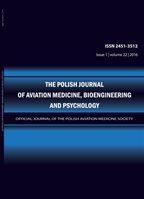2024, Volume 30, Issue 1
MILITARY AEROMEDICAL EVALUATION IN CARDIOMYOPATHIES AND HEART FAILURE: A REVIEW OF CURRENT GUIDELINES
MICHAŁ A. KUREK1, MAGDALENA ROLA2, ŁUKASZ DZIUDA3
-------------------------------------------------------------------------------------------------
1Department of Internal Disease, Military Institute of Aviation Medicine
2Military Aviation Medical Board
3Department of Psychophysiological Measurements and Human Factor Research, Military Institute of Aviation Medicine
Autor korenspondencyjny: MICHAŁ A. KUREK; Department of Internal Disease, Military Institute of Aviation Medicine; email: mkurek1978@gmail.com
Full text
Streszczenie
Introduction: Cardiomyopathies and heart failure are conditions of diverse etiology and clinical course, posing a significant challenge within the aviation population due to the risk of sudden cardiac events. The aim of this paper was to present the current state of knowledge on these diseases in the context of military aeromedical evaluation.
Methods: This is a review article based on an analysis of scientific publications from the PubMed and Google Scholar databases. The study takes into account the guidelines of the European Society of Cardiology, NATO recommendations, and regulations applied in the air forces of various countries.
Results: The main phenotypes of cardiomyopathies and heart failure were discussed in the context of their clinical and aeromedical relevance among military pilots. Diagnostic criteria were presented, along with the differentiation between pathological changes and physiological training adaptations, as well as the role of modern diagnostic tools such as imaging and genetics.
Discussion and Conclusions: Although cardiomyopathies and heart failure are rare among military pilots, they are associated with the risk of sudden events and constitute a significant limitation in flight clearance. Advancements in imaging diagnostics, genetics, and risk assessment now allow for a more individualized approach to aeromedical certification, particularly in cases of mild cardiomyopathy phenotypes. An increasing body of evidence suggests that selected pilots diagnosed with myocardial disease, in the absence of high-risk features, may safely continue duties within a limited scope. However, this requires strict selection criteria, regular clinical monitoring, and ongoing research into operational safety within this professional group.
Słowa kluczowe
cardiomyopathies, heart failure, military medicine, aviation medicine, risk assessment, medical certification
